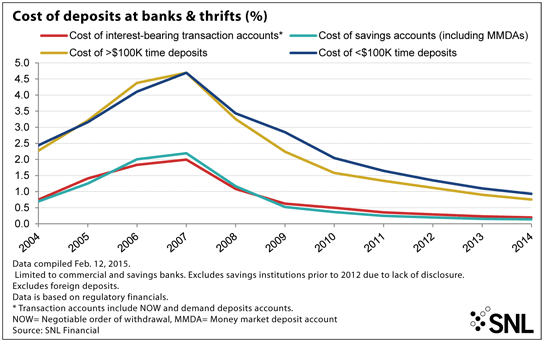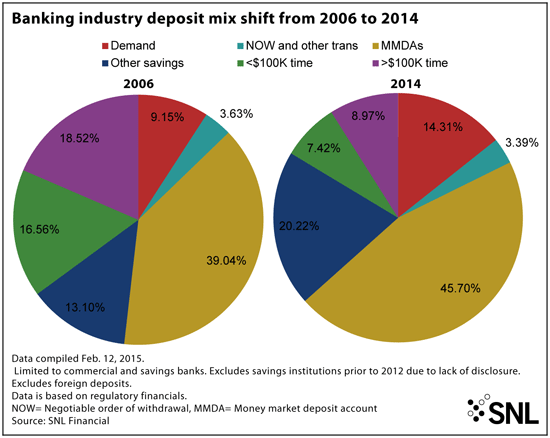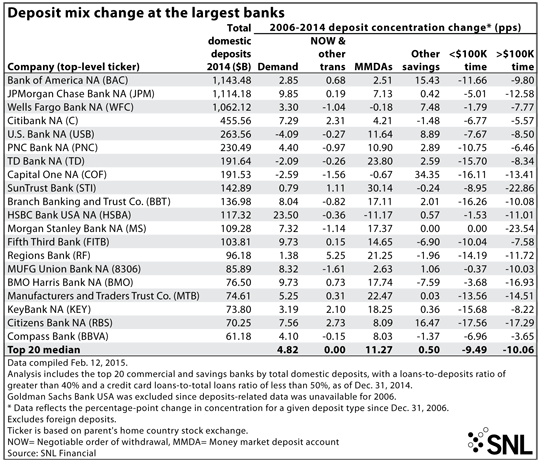Weigh costs, benefits of rate rise
SNL Report: Modest interest rates kept Q4'14 deposits costs historically low—but what’s coming?
- |
- Written by SNL Financial

By Kevin Dobbs and Zuhaib Gull, SNL Financial staff writers
Though anticipation of a hike in short-term interest rates has permeated the banking industry for years, it has yet to materialize, leaving funding costs exceptionally low at the end of 2014. And, at least for early 2015, industry insiders say there is little reason to expect a change.
The cost of deposits at U.S. banks and thrifts hovered well below historical averages throughout 2014 and finished the year far lower than where they were in 2006 and 2007, the years preceding the last financial crisis, an SNL Financial analysis of regulatory filings shows. The Federal Open Market Committee, the Federal Reserve's policymaking arm, drove down short-term rates in the aftermath of the crisis. At the close of 2014, costs of savings accounts and interest-bearing transaction accounts were near zero, as they had been for several years prior.
 For a larger version, click on the image.
For a larger version, click on the image.
Ernest Goss, a Creighton University economist who researches banking, told SNL that if retail sales rebound from the weak performances of the past couple months —Goss thinks consumers have yet to spend the savings they have enjoyed on lower gasoline prices in recent months—and employment data remains strong over the next few months, the Fed likely will start to lift rates this summer.
Over the past three months, the U.S. economy added more than a million jobs and recorded the most robust three-month hiring period since the late 1990s, according to the U.S. Labor Department's latest employment report. Average hourly earnings increased 0.5% in January, providing a long-awaited sign that wages are heading upward following years of stagnation, Goss said.
If hiring continues and stronger wages encourage more consumer spending, he said, the Fed should have the ammunition it needs to boost rates at its June meeting or shortly thereafter.
But, Goss said, his is a prediction clouded by uncertainties on the jobs and consumer spending fronts—the global economy is laced with threats to growth that could throw a wrench into the U.S. recovery—and that helps explain why economists broadly are divided on the timing of a rate increase.
[Editor’s Note: Indeed, in testimony Feb. 25, Federal Board Chairman Janet Yellen stated that the Federal Open Market Committee’s “assessment that it can be patient in beginning to normalize policy means that the Committee considers it unlikely that economic conditions will warrant an increase in the target range for the federal funds rate for at least the next couple of FOMC meetings.” The committee hold eight regularly scheduled meetings and other meetings as needed.]
Differing views
At an American Bankers Association conference this month, for instance, two prominent economists who track the banking industry were far apart in their forecasts on rates and growth. Scott Anderson, chief economist at Bank of the West, anticipates GDP growth of 3.1% for 2015 and a Fed rate increase at policymakers' June meeting. Sterne Agee & Leach Chief Economist Lindsey Piegza, in contrast, forecasts GDP growth of 2.1% for 2015 and a rate hike waiting until 2016. Piegza cited global economic tumult as a major concern.
"You really have people on different sides of this," Goss said, "and that's understandable."
Goss said that, even if his forecast proves accurate, he thinks the Fed will move cautiously, raising rates by no more than 25 basis points initially, and then perhaps waiting several months before boosting further. As such, he said, there is little reason to expect a surge in funding costs this year.
"When it happens, it will not be a large increase, and the Fed will move carefully," Goss said. "I think on that much there is a consensus."
 For a larger version, click on the image.
For a larger version, click on the image.
Getting ready for rising rates
All of that noted, banks still have time to prep for a different environment, to position themselves to be able to boost rates on loans—generating more interest income—and to more than offset increases in what they pay on deposits, observers say. Time to prepare is important, observers say, because banks likely will see a shift in their deposit mixes when rates do increase substantially. [Editor’s Notes: For more thinking on this, see both the latest “ALCO Beat: Reflections on rising rates” and Brian Higgin’s guest blog “Prepare now for rising rates.”]
Over the last several years, while rates have been low, many Americans put their cash in flexible money market demand accounts. MMDAs accounted for 45.7% of U.S. deposits in the fourth quarter of 2014, up from about 39% at the end of 2006, according to the SNL analysis. Banks run by major financial companies such as SunTrust Banks Inc., Regions Financial Corp. and M&T Bank Corp., for example, have seen big double-digit percentage-point increases in their MMDA concentrations since 2006.
Higher interest rates would likely motivate bank customers to shift their money into less flexible but higher interest-producing accounts such as CDs, creating new levels of competition to keep or attract new depositors, said Charles Wendel, president of Financial Institutions Consulting Inc.
Wendel cautioned that while banks may have time to position themselves for higher rates, many still have much work to do. If too many lenders do not have plans in place to both retain depositors and boost interest income on loans, a higher rate environment could actually hurt the banking sector, he said, countering the current prevailing thinking that higher rates are all but a certain positive.
Take care waiting for “pot of gold”
"There are a lot of banks that are prepared for this, but there are many others that are not," Wendel told SNL. "And they could just find themselves paying more" for deposits.
The bank industry, he continued, "seems to be desperately waiting for its pot of gold" in the form of higher rates. "And I think that's dangerous."
At some point there will be rate increases, he said, but when, how much and how often? Few if any outside the Fed know the answers to those questions, he said. So it is difficult to gauge the degree to which the industry as a whole will benefit.
"It's not clear that a rate hike will help the group as much as many think," Wendel said.
Print an SNL Financial Reprint of this article.
Tagged under Management, Financial Trends, Risk Management, Rate Risk, Feature, Feature3,















